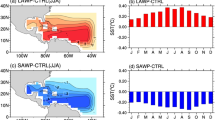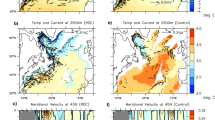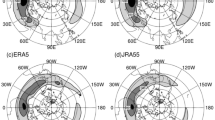Abstract
Atmospheric moisture transport from the Atlantic to the Pacific basin plays an important role in regulating North Atlantic salinity and thus the strength of the thermohaline circulation. Potential changes in the strength of this moisture transport are investigated for two different climate-change scenarios: North Atlantic cooling representative of Heinrich events, and increased greenhouse gas (GHG) forcing. The effect of North Atlantic cooling is studied using a coupled regional model with comparatively high resolution that successfully simulates Central American gap winds and other important aspects of the region. Cooler North Atlantic sea surface temperature (SST) in this model leads to a regional decrease of atmospheric moisture but also to an increase in wind speed across Central America via an anomalous pressure gradient. The latter effect dominates, resulting in a 0.13 Sv (1 Sv = 106 m3 s−1) increase in overall moisture transport to the Pacific basin. In fresh water forcing simulations with four different general circulation models, the wind speed effect is also present but not strong enough to completely offset the effect of moisture decrease except in one model. The influence of GHG forcing is studied using simulations from the Intergovernmental Panel on Climate Change archive. In these simulations atmospheric moisture increases globally, resulting in an increase of moisture transport by 0.25 Sv from the Atlantic to Pacific. Thus, in both scenarios, moisture transport changes act to stabilize the thermohaline circulation. The notion that the Andes effectively block moisture transport from the Atlantic to the Pacific basin is not supported by the simulations and atmospheric reanalyses examined here. This indicates that such a blocking effect does not exist or else that higher resolution is needed to adequately represent the steep orography of the Andes.













Similar content being viewed by others
References
Benway HM, Mix AC, Haley BA, Klinkhammer GP (2006) Eastern Pacific warm pool paleosalinity and climate variability: 0–30 kyr. Paleoceanography 21. doi:10.1029/2005PA001208
Broecker WS (1997) Thermohaline circulation, the Achilles heel of our climate system: will man-made CO2 upset the current balance? Science 278:1582–1588
Broecker WS (2003) Does the trigger for abrupt climate change reside in the ocean or in the atmosphere? Science 300:1519–1522
Chan WL, Motoi T (2005) Response of thermohaline circulation and thermal structure to removal of ice sheets and high atmospheric CO2 concentration. Geophys Res Lett 32:L07601
Clark PU, Pisias N, Stocker TF, Weaver AJ (2002) The role of the thermohaline circulation in abrupt climate change. Nature 415:863–869
Dickinson RE, Henderson-Sellers A, Kennedy PJ (1993) Biosphere–atmosphere transfer scheme (BASTS) version 1e as coupled to the NCAR Community Climate Model. NCAR tech note NCAR/TN-387 + STR, pp 72
Edwards JM, Slingo A (1996) Studies with a flexible new radiation code. I. Choosing a configuration for a large-scale model. Quart J Roy Meteorol Soc 122:689–719
Gregory JM et al (2005) A model intercomparison of changes in the Atlantic thermohaline circulation in response to increasing atmospheric CO2 concentration. Geophys Res Lett 32:L12703 10.1029/2005GL023209
Hemming SR (2004) Heinrich events: massive late Pleistocene detritus layers of the North Atlantic and their global climate imprint. Rev Geophys 42:RG1005. doi:10.1029/2003RG000128
Hewitt CD, Broccoli AJ, Crucifix M, Gregory JM, Mitchell JFB, Stouffer RJ (2006) The effect of a large freshwater perturbation on the glacial North Atlantic Ocean using a coupled general circulation model. J Clim 19:4436–4447
Hu A, Otto-Bliesner BL, Meehl GA, Han W, Morrill C, Brady EC, Briegleb B (2008) Response of thermohaline circulation to freshwater forcing under present-day and LGM conditions. J Clim 21:2239–2258
Kalnay E et al (1996) The NCEP/NCAR 40-year reanalysis project. Bull Am Meteorol Soc 77:437–471
Langland RH, Liou CS (1996) Implementation of an E–ε parameterization of vertical subgrid-scale mixing in a regional model. Mon Wea Rev 124:905–918
Latif M, Roeckner E, Mikolajewicz U, Voss R (2000) Tropical stabilization of the thermohaline circulation in a greenhouse warming simulation. J Clim 13:1809–1813
Leduc G, Vidal L, Tachikawa K, Rostek F, Sonzogni C, Beaufort L, Bard E (2007) Moisture transport across Central America as a positive feedback on abrupt climatic changes. Nature 445:908–911
Levitus S (1982) Climatological Atlas of the World Ocean. NOAA prof. paper no. 13, pp 173 and 17 microfiche
Lohmann G (2003) Atmospheric and oceanic freshwater transport during weak Atlantic overturning circulation. Tellus 55A:438–449
Lohmann G, Lorenz S (2000) On the hydrological cycle under paleoclimatic conditions as derived from AGCM simulations. J Geophys Res 105:17417–17436
Manabe S, Stouffer RJ (1988) Two stable equilibria of a coupled ocean–atmosphere model. J Clim 1:841–866
Manabe S, Stouffer R (1994) Multiple-century response of a coupled ocean–atmosphere model to an increase of atmospheric carbon dioxide. J Clim 7:5–23
Onogi K et al (2007) The JRA-25 Reanalysis. J Meteorol Soc Jpn 85:369–432
Pacanowski RC (1996) Documentation user’s guide and reference manual of MOM2, version 2. GFDL ocean tech rep 3.2, Princeton, NJ, pp 329
Pahnke K, Sachs J, Keigwin L, Timmermann A, Xie S-P (2007) Eastern tropical Pacific hydrologic changes during the past 27,000 years from D/H ratios in alkenones. Paleoceanography 22. doi:10.1029/2007PA001468
Peltier WR, Vettoretti G, Stastna M (2006) Atlantic meridional overturning and climate response to Arctic Ocean freshening. Geophys Res Lett 33:L06713. doi:10.1029/2005GL025251
Romanova V, Prange M, Lohmann G (2004) Stability of the glacial thermohaline circulation and its dependence on the background hydrological cycle. Clim Dyn 22:527–538
Schiller A, Mikolajewicz U, Voss R (1997) The stability of the thermohaline circulation in a coupled ocean–atmosphere model. Clim Dyn 13:325–348
Stouffer R, Manabe S (1999) Response of a coupled ocean–atmosphere model to increasing atmospheric carbon dioxide: sensitivity to the rate of increase. J Clim 12:2224–2237
Stouffer RJ, Yin J, Gregory JM, Dixon KW, Spelman MJ, Hurlin W, Weaver AJ, Eby M, Flato GM, Hasumi H, Hu A, Jungclaus JH, Kamenkovich IV, Levermann A, Montoya M, Murakami S, Nawrath S, Oka A, Peltier WR, Robitaille DY, Sokolov A, Vettoretti G, Weber SL (2006) Investigating the causes of the response of the thermohaline circulation to past and future climate changes. J Clim 19:1365–1387
Sun Z, Rikus L (1999) Improved application of exponential sum fitting to inhomogeneous atmosphere. J Geophys Res 104:6291–6303
Swingedouw D, Braconnot P, Delecluse P, Guilyardi E, Marti O (2007) Quantifying the AMOC feedbacks during a 2×CO2 stabilization experiment with land–ice melting. Clim Dyn 29:521–534
Tiedtke M (1989) A comprehensive mass flux scheme for cumulus parameterization in large-scale models. Mon Wea Rev 117:1779–1800
Timmermann A, Okumura Y, An SI, Clement A, Dong B, Guilyardi E, Hu A, Jungclaus JH, Renold M, Stocker TF, Stouffer RJ, Sutton R, Xie SP, Yin J (2007) The influence of a weakening of the Atlantic meridional overturning circulation on ENSO. J Clim 20:4899–4919
Uppala SM et al (2005) The ERA-40 re-analysis. Quart J Roy Meteorol Soc 131:2961–3012
Wang Y (2001) An explicit simulation of tropical cyclones with a triply nested movable mesh primitive equation model: TCM3. Part I. Model description and control experiment. Mon Wea Rev 129:1370–1394
Wang Y, Sen OL, Wang B (2003) A highly resolved regional climate model (IPRC-RegCM) and its simulation of the 1998 severe precipitation events over China. Part I. Model description and verification of simulation. J Clim 16:1721–1738
Wang Y, Xie S-P, Xu H, Wang B (2004) Regional model simulations of marine boundary layer clouds over the southeast Pacific off South America. Part I. Control experiment. Mon Wea Rev 132:274–296
Xie S-P, Xu H, Kessler WS, Nonaka M (2005) Air–sea interaction over the eastern Pacific warm pool: gap winds, thermocline dome, and atmospheric convection. J Clim 18:5–25
Xie S-P, Miyama T, Wang Y, Xu H, de Szoeke SP, Small RJ, Richards KJ, Mochizuki T, Awaji T (2007) A regional ocean–atmosphere model for eastern Pacific climate: towards reducing tropical biases. J Clim 20:1504–1522
Xie S-P, Okumura Y, Miyama T, Timmermann A (2008) Influences of Atlantic climate change on the tropical Pacific through the Central American isthmus. J Clim 21:3914–3928
Xu H, Xie S-P, Wang Y, Small RJ (2005) Effects of Central American mountains on the eastern Pacific winter ITCZ and moisture transport. J Clim 18:3856–3873
Zaucker F, Broecker WS (1992) The influence of atmospheric moisture transport on the fresh water balance of the Atlantic drainage basin: general circulation model simulations and observations. J Geophys Res 97:2765–2773
Zheng Y, van Geen A, Anderson RF, Gardner JV, Dean WE (2000) Intensification of the northeast Pacific oxygen minimum zone during the Bölling-Alleröd warm period. Paleoceanography 15:528–536
Zhou T, Zhang X, Wang S (2000) The interbasin transport of atmospheric moisture evaluated from NCEP/NCAR reanalysis data. Acta Meteorol Sin 14:159–172
Acknowledgments
This study was supported by the NOAA Climate Program Office, and the Japan Agency for Marine-Earth Science and Technology (JAMSTEC) through its sponsorship of the International Pacific Research Center. The authors are grateful to the following individuals for generously providing us with their water hosing data: Ronald Stouffer and Jianjun Yin (GFDL CM 2.1), Aixue Hu (NCAR CCSM 2.0), Jonathan Gregory and Kevin Marsh (UKMO HadCM 3), and Guido Vettoretti (UToronto). The authors wish to thank Justin Small for help in the moisture transport calculations and valuable comments on the manuscript. Thanks also to the three anonymous reviewers for their helpful suggestions. IPRC/SOEST publication #660/7857.
Author information
Authors and Affiliations
Corresponding author
Rights and permissions
About this article
Cite this article
Richter, I., Xie, SP. Moisture transport from the Atlantic to the Pacific basin and its response to North Atlantic cooling and global warming. Clim Dyn 35, 551–566 (2010). https://doi.org/10.1007/s00382-009-0708-3
Received:
Accepted:
Published:
Issue Date:
DOI: https://doi.org/10.1007/s00382-009-0708-3




